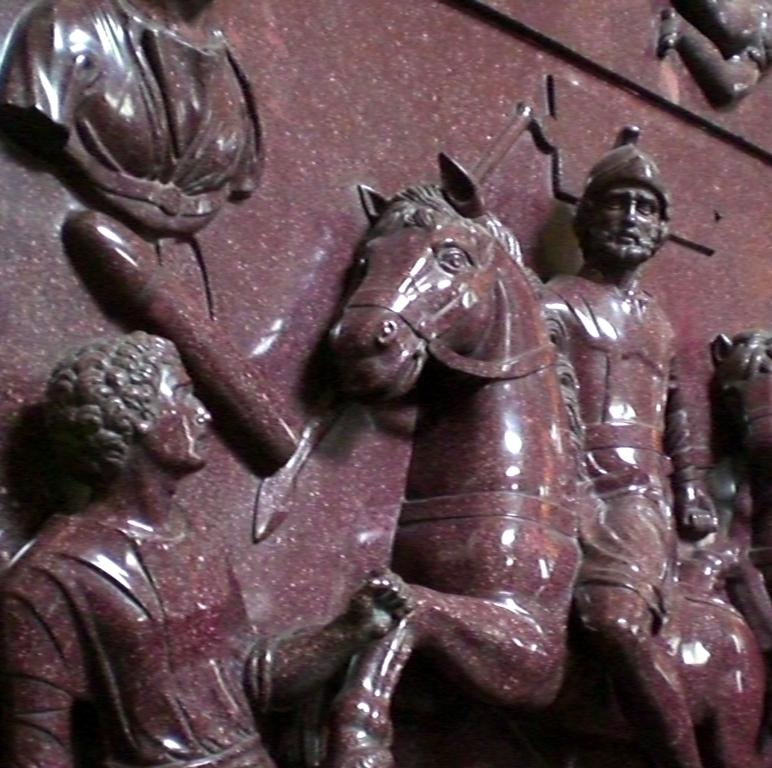 Roman Military Victory:
Scene on the Sarcophagus of Helena, Mother of Emperor Constantine,
4th c AD. Red Marble Porphyry. Vatican Museums, Rome
Roman Military Victory:
Scene on the Sarcophagus of Helena, Mother of Emperor Constantine,
4th c AD. Red Marble Porphyry. Vatican Museums, Rome
Rome on the Move
From Expansion to
Civil War
The Leaders
The Led
The Losers
Remembering War:
The Roman "Triumph"
|
|
Roman Warfare: The Leaders, The Led, The Losers
In the Vatican Museums in
Rome stands the marble sarcophagus of Helena, mother of the
Emperor Constantine. It's dense and red, almost glowing, as
if Roman domination from long ago is shouting out to
us.
The Romans are protected by metal helmets and body armor. Their
weapons are large and heavy. They
charge on fierce and frightening horses.
The defeated stand below the riders, some in chains. None exhibit
the horrific wounds common in ancient pitched battles. Nor
the signs of starvation or disease typical from siege warfare.
They are beaten down by something more powerful: Roman
relentlessness.
Notable Commanders:
King Numa Pompilius
Camillus
Marius
Sulla
Pompey
Julius_Caesar
Notable Losers:
The Etruscans
Pyrrhus
Hannibal
SOURCES
|
|
|
|
|
|
|
|
|
ROME ON THE MOVE
The City of Rome was founded, in legend, around 750 BC.
For the next two hundred
years, it perched precariously among the
ferocious groups on the Italian peninsula. Still small,
still behind the Etruscans, rather a nothing.
Then, around 550 BC, Rome began to conquer and expand.
It kept fighting for the next 500 years.
Within
300 years, Rome had defeated everyone in Italy. The defeated
often became "allies," whose purpose was to provide units of
soldiers under the command of the Roman Army, and treasure
to support them.
By the time of Julius Caesar's death in 44 BC, the Mediterranean had become a "Roman
lake."
Roman armies with their perpetual manpower machine could
fight
east or west.
Spain was prized
for its metals and minerals, the southern Mediterranean/North Africa for its
granaries, and the East (the Middle East) for its rich cities.
The lands north of the Alps, the heart of today's
Europe, did not count for much.
|
|

Roman Empire
at the death of Julius Caesar, 44 BC.
Map courtesy
Ancient World Mapping Center.
|
|
|
|
|
|
FROM EXPANSION TO
CIVIL WAR |
|
|
|
|
|
|
Julius Caesar was
assassinated in 44 BC. His murder restarted the civil wars
that Marius and Sulla had waged in the 80's. A generation
of Romans had since known peace, but the memories of the
earlier trauma remained. Perhaps the renewed strife appeared
as cyclical and thus inevitable. In Epode 16, Horace wrote
that his generation of Romans were "of cursed blood."
In his view, what even Hannibal could not accomplish--the
destruction of Rome-- Rome would.
This Civil War was
also a major event in Mediterranean history.
The Romans
had extended their domination beyond the Italian peninsula.
From Syria to Spain and in northern Europe, cities, towns,
and villages were affected by the Civil War's chaos and violence.
The Civil War was the "total war" of
the ancient world. Military participation from the
17-to-46 age group was high--about 25%-- meaning every Roman
family probably had at least one male in the War. Political purges carried out by
dreaded killing squads finished off many more. Mothers
and wives at all levels had many dead sons and husbands to
mourn.
The demands of the Civil War changed some of Rome's most
bedrock social institutions. Women were taxed, unheard of and undermining the sacredness of the
marriage contract. The place of the Army in society changed:
no longer was it unusual to see an Army inside the pomerium,
the sacred boundary, of Rome.
Property of Romans, including entire towns, was
expropriated. Often the lands were
later given to soldiers as a reward and lost forever to
their rightful and often innocent family.
Treasure from sacred temples were carted
off. Taxes everywhere increased.
Cicero wrote that it was a time when chance counted for more
than reason. Caesar's assassins won some battles and lost others.
Finally defeated by Marc Anthony, Octavian (Julius Caesar's
teen-aged adopted nephew), and others, the assassins left
the stage but the victors quickly declared
war on each other. Eventually just Marc Anthony-
Cleopatra were left to battle it out with Octavian. Octavian
won. Marc
Anthony and Cleopatra committed suicide.
Octavian went on to
become Emperor Augustus. Surprising to everyone considering
Octavian's extreme brutality during the Civil War, internal peace
descended on the Roman empire,
though at the price of autocratic rule, for the next 41
years.
As for Cicero, by chance or by reason, he had chosen the wrong side.
Proscribed, Marc Anthony's soldiers murdered him near one of
his country estates. Cicero's head and his writing hand were cut off and carted back to
Rome for display on the Rostra in the Roman Forum.
|
|
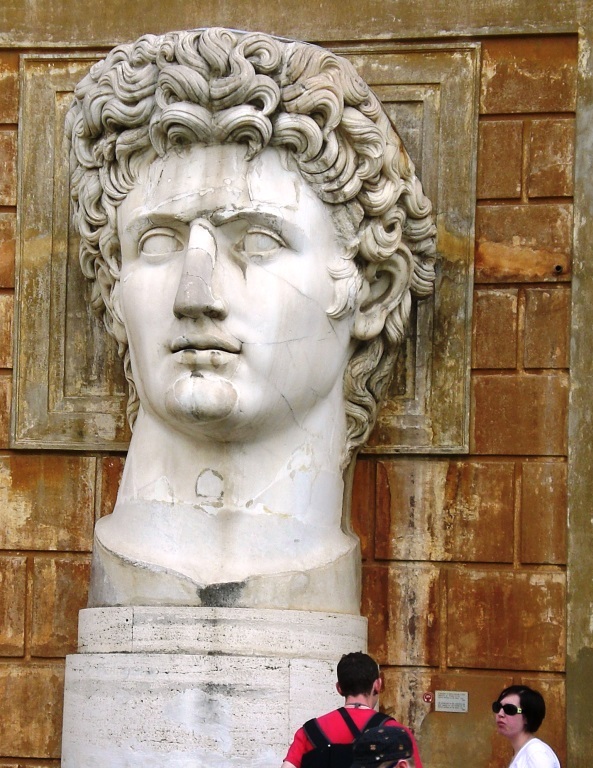
The Emperor Augustus.
Pinecone
Courtyard, Vatican Museums, Rome.
Horace in Epode 16: "A Remedy for Civil War" wrote:
"Another generation now's been ground down by civil war, and
Rome herself's being ruined by her own power..." Survivors carried the memory of the
uncertain, violent times for decades.
|
|
|
|
|
THE LEADERS
The Art of Generalship
What did Rome expect of a military leader?
Political deftness: To obtain a command, a Roman male had to
get to the top of the political heap. The head Commanders of the Army
were the two elected Consuls of Rome. Politics were nasty,
brutish, and highly competitive.
"Virtus:"
Roughly, courage and steadfastness
in daily life and on the battlefield. In war, a general
showed he had "virtus" by embracing personal danger. A Roman general
was at the front; he did not direct the war from
headquarters.
Relentlessness: pursue the enemy until it was defeated. No
negotiated peace.
Physical endurance: travel long distances on horseback on
poor roads or tracks, in all kinds of weather.
Psychological endurance: be away from Rome for years at a
time.
The favor of the gods: Military defeat meant the gods had
been offended, putting the Roman state in danger. A Roman commander
who lost was
worse than incompetent, he was a threat to all other Romans. |
|

Julius Caesar
, 100-44 BC/span>.
Rome's
most brilliant of generals.
|
|
|
|
|
|
|
THE LED
Who was in the
Army:
In very early Rome, the army
was composed of citizen-soldiers who served only part-time. temporary
military force.
Each
property-owning Roman citizen mobilized for war once a year.
16 campaign "seasons" --from the time the crops were sown
until they were ready to harvest-- were owed.
The citizen-soldier brought his own
equipment, weapons, and money for food. He could expect no pay
from the state.
The Romans
with the most property were in the cavalry, since a horse, its armament, and
upkeep were extra expenses beyond the reach of all but a
few.
Even within the infantry, soldiers were assigned by property. The heavy infantry, for example, required Class I property-- a helmet, round shield, greaves,
cuirass, spear, and sword.
As Rome expanded and began overseas campaigns and triumphs,
the Army recruited longer-serving, full-time soldiers, many
from the Allied provincial towns.
How they
fought:
The soldiers of the Roman Army were exceptional among
ancient armies in their patience and discipline as a unit.
Laying out the battle could take days, with the fighting
itself lasting hours and hours.
Once the battle started, hand to hand combat occurred as
the lines closed on each other.
In Roman tactics,
Roman soldiers did not rush headlong forward like a mob. Under
the screams and pushing of their officers, they moved
forward, fought, paused and backed up a little, then pushed forward
again.
As the two sides grappled, more soldiers from poured in, until one side gave in and fled.
The Roman commander held back a reserve. Those in the
middle of the scrum had to hold on, trapped, until the reserves
were sent in.
To keep the unit together under these frightening
conditions, harsh
training was routine.
Soldiers gave up their rights as
Roman citizens while in the military. Some of the citizen's
most important protections evaporated: a soldier could
be sentenced to a brutal beating for any reason. He could be put to death
without a trial.
Still, few Romans evaded their military duty or deserted. |
|
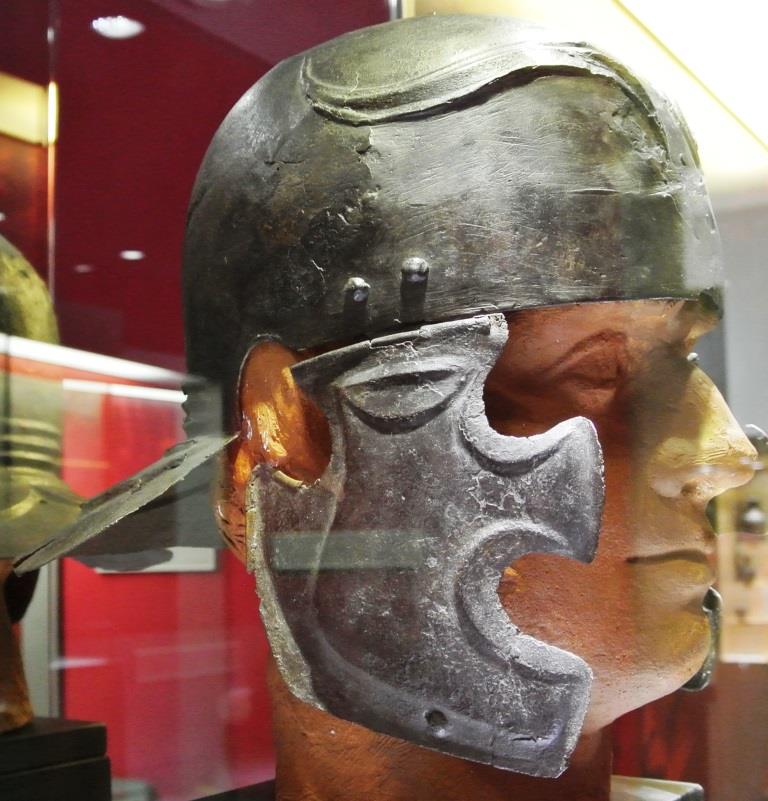 Roman Helmet, cone
shaped. 1st
c BC. The Balkans. The conical top protected the head.The
flap in the rear protected the neck. Not much protected the
eyes, nose, or lips.
National
Archeological Museum, Zagreb. Roman Helmet, cone
shaped. 1st
c BC. The Balkans. The conical top protected the head.The
flap in the rear protected the neck. Not much protected the
eyes, nose, or lips.
National
Archeological Museum, Zagreb.
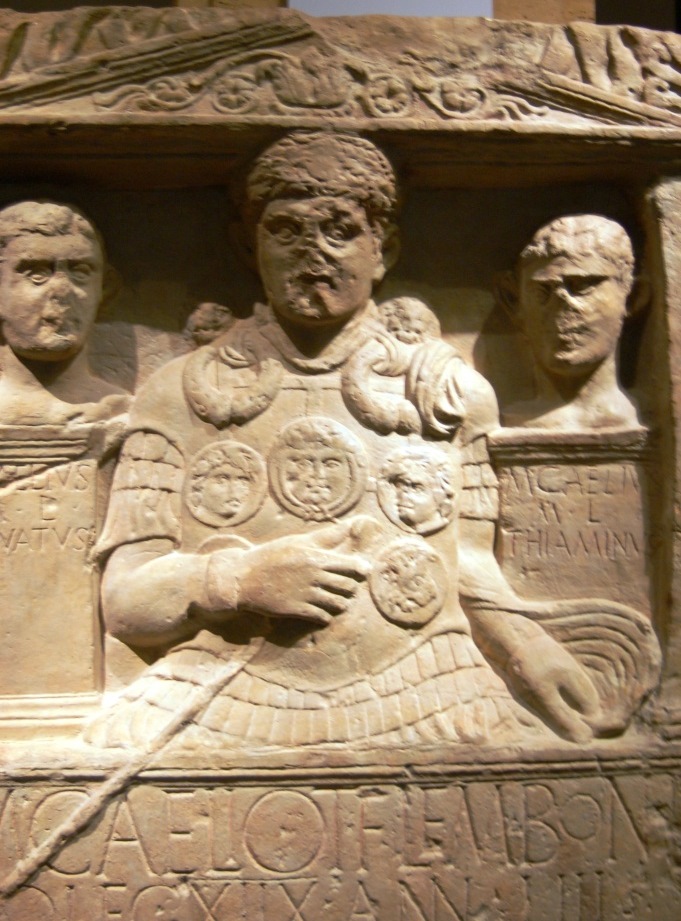 Altar for Marcus Caelius Rufus. This
military unit had its "genius," a kind of guardian spirit
that guided and helped form 'esprit d'corps.' Berlin, German
History Museum. Altar for Marcus Caelius Rufus. This
military unit had its "genius," a kind of guardian spirit
that guided and helped form 'esprit d'corps.' Berlin, German
History Museum.
|
|
|
|
|
THE LOSERS
Who exactly were the opponents? Almost no
accounts from their side are left. Some tribes were illiterate. Sadder, those
who were literate, like the Etruscans, found their language and
culture erased by the triumphant Romans.
We
are left with the remains of a few mute wood huts and
shards of metal. But, thanks to modern archeology, art
history, and science, we can say that most of Rome's opponents
did not create peaceable kingdoms.
They maintained
their power internally by brute force and compulsion.
They aggressively sought others'
territories.
Sometimes,
they defeated the Roman Legions. Hannibal, as we know, was a brilliant battlefield general who kept
the Romans on the run inside Italy for years.
Some were
successful
in siege warfare.
They could adopt a scorched-earth approach, even of
innocent farmers, as ruthlessly as the Romans.
Like
the Romans, they sold the defeated into slavery and took
booty of all kinds, including women and children.
|
|
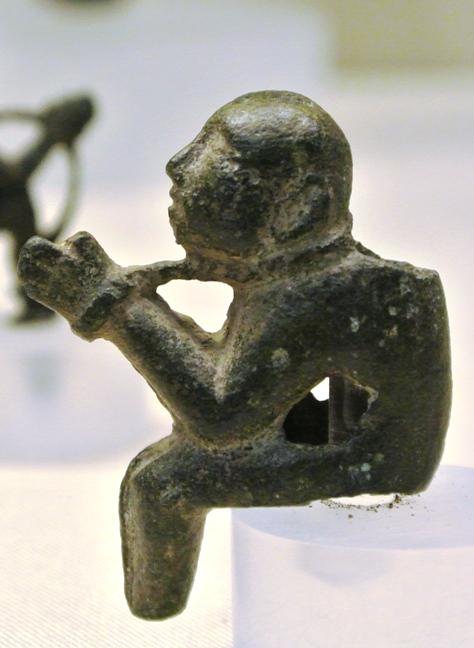 Roman Prisoner
of War.
The defeated
were sold into slavery.
Bronze. 2nd c AD,
British Museum. Roman Prisoner
of War.
The defeated
were sold into slavery.
Bronze. 2nd c AD,
British Museum.
|
|
|
|
|
REMEMBERING WAR:
The "Triumph"
"Remembrance" by
Rome of its military victories was about remembering who was
in charge: the very few members of an elite aristocracy.
The Roman state did not erect
memorials to ordinary soldiers who perished. There was no "Tomb
of the Unknown Soldier."
There were no signs of the
women, children, and by-standers who died in the wars.
The "Triumph" was the quintessential Roman signature of victory. A Roman Triumph
was a grand spectacle-parade-festival, the championship prize for a
commander.
The victorious
commander petitioned the Senate for
permission to stage his Triumph, which the general paid for. The Senate awarded about
300 Triumphs between 750 BC and the reign of Augustus,
700 years later.
Those refused might get a lesser "Ovation" or a special date
on the Roman calendar.
The Triumph was held
inside the city walls of Rome. The commander would be
clothed in purple, his head crowned by a laurel wreath. He
rode in a chariot drawn by four white horses. Since this
appeared to be flirting pretty close to
god-status, a runner whispered in his ear "You are but a
man."
The defeated, including families of the leader, were paraded
at the front in chains. They were on their way to execution.
Gold and silver, statues and artworks, from the looted
cities dazzled the throngs.
Large paintings of the crucial battles were carried along
the parade route; the ordinary
Roman could feel he was right there, on the battlefield.
Civil
War victories such as Pharsalus, Philippi, and Actium
presented a special problem. How could a commander parade fellow Romans,
aristocrats from the oldest families, in
shackles and on their way to execution. No "Triumph" was ever
awarded by the Senate to celebrate a Civil War
victory.
|
|
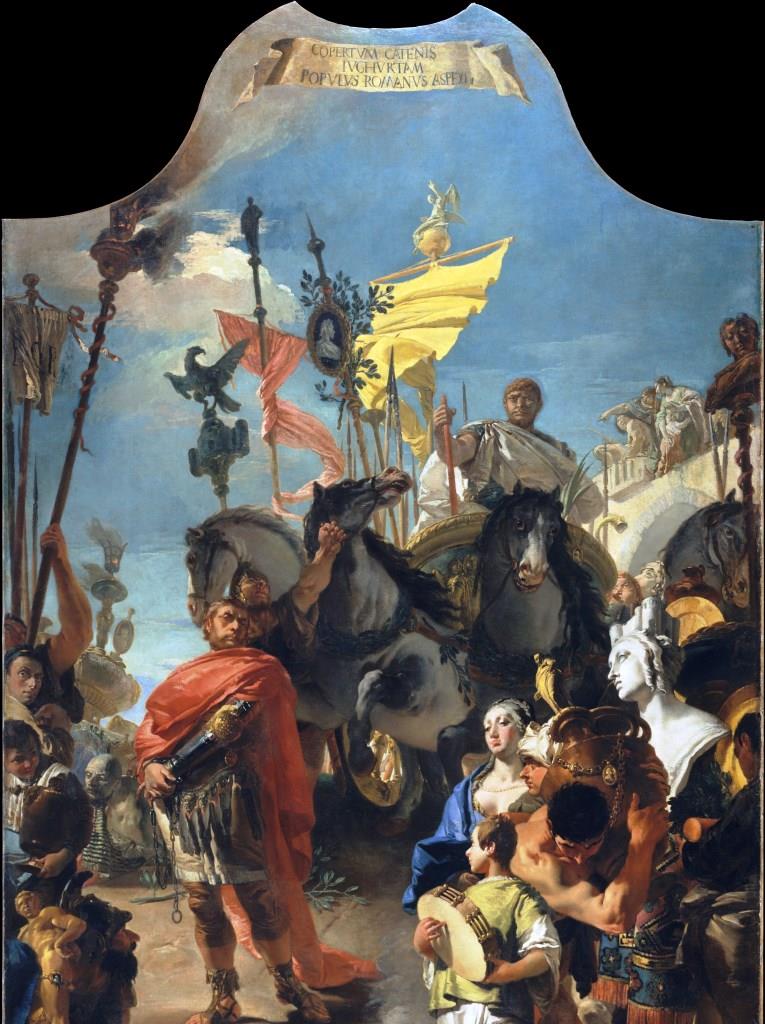
Triumph of
Marius
by G.B. Tiepolo, 1729.
New York
Met .
The
defeated King Jugurtha of North Africa, though in chains,
is wrapped in a crimson garment, his head raised high and
proud. Unlikely.
Jugurtha is on his way to death by starvation.
|
|
|
|
|
|
|
|
|
|
NOTABLE COMMANDERS |
|
|
| |
|
|
King Numa Pompilius
: The Road Not Taken
In
its early days, Rome was a semi-barbaric
place. It was peopled by the dispossessed, the desperate, and the
destitute.
Essentially, a place for those with nowhere else to go.
To rule over this bunch, there were (maybe) seven Kings of
Rome. Numa Pompilius (7th c BC.) was the second king. He reigned for 43 years,
creating order out of chaos, and gave a place for fugitives and runaway
slaves.
Numa founded the Temple of Janus.
The Temple's
doors were to be closed in peace and open in wartime. He
decided on peace. The Temple doors
were closed and remained closed for 40 years.
The legacy of Numa was "the road not taken" by the Romans.
Numa was unable to imprint upon the Romans either a willingness
or the
ability to live peaceably among their neighbors.
After Numa's reign, the Temple doors were open, that
is, "open to war" for nearly 500
years, as Rome fought year after year after year.
|
|
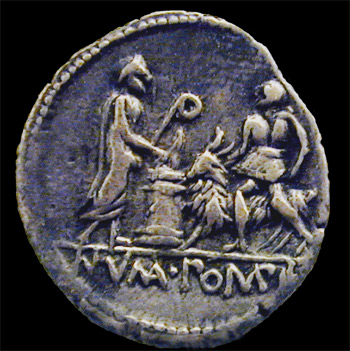 Numa
Pompilius Sacrificing a Goat.
Roman coin minted
around 100 BC.
Courtesy: VRoma. Numa
Pompilius Sacrificing a Goat.
Roman coin minted
around 100 BC.
Courtesy: VRoma.
|
| |
|
|
|
|
|
|
Camillus
: The Second Founder of Rome
In Florence, Italy, you can see a 16th c fresco nearly a
wall long
inside the Palazzo Vecchio. It's
Camillus. Camillus is gloriously clad as a
near-mythological hero, atop a chariot pulled by white
horses , with too many legs, gazing at his (imagined) Roman
armament. The losers, bound with heads in conquered-slave position
are practically underneath the chariot.
Who was this Camillus?
Camillus led the Romans to their first great military
success, at Veii against the superior Etruscans. Then he
drove off the invading Gauls.
The Etruscan city-states dominated the central Italian peninsula. Veii, one of the
main city-states, was only a few miles north of Rome. Veii
gushed with wealth, and was both culturally and militarily
ahead of Rome. The two cities had fought on-and-off for
years.
Camillus crushed them through siege warfare. Their
civilization effectively ended.
Ten years later, Camillus, at that time in exile, returned
to lead the Romans against an invasion of Gauls. The Gauls
employed a frightening military style: they charged headlong
in a fury, scattering their opponents like bowling balls.
They sacked Rome, an traumatic event that was seared into
Rome's collective memory.
Camillus devised close combat tactics to counter the
ferocious charge of the Gauls, and apparently succeeded in
training his troops to stand their ground and fight back as
a group. Arriving too late to prevent the sack of Rome
(386 BC), he drove the Gauls away from the area before they
could assume control of the City and its hinterland.
Most importantly, Camillus persuaded the
discouraged people of Rome not to leave their destroyed town.
He was indeed "The Second Founder of Rome."
|
|

Marcus Furius
Camillus (c 450-365 BC)
Triumph over the
Etruscans at Veii.
Fresco by Francesco Salviato. 16th c.
Florence, Palazzo Vecchio.
Photo: Wikipedia.
Camillus was awarded
four military "triumphs." Five times he was named "dictator"
--a commander with temporary extraordinary powers to do
whatever was needed to save Rome.
Camillus died of
illness, possibly a
plague, aged 82.
|
| |
|
|
|
|
|
|
Generals of the Roman Republic: Marius, Sulla, Pompey, and
Caesar
Marius, Sulla, Pompey, and
Julius Caesar: able, popular, and aggressive. They could
command large armies in different theaters, lead personally
on the battlefield, win where others could not, and
ruthlessly trump their peers in politics. Military fame and
the wealth
from victories, especially in the "East," propelled them far beyond
others of their
day.
These same characteristics led to fear and envy. To become
ever more wealthy, a general had to seek more commands,
bribing and intimidating to get them. For each person awarded
the military command, someone else equally ambitious lost
the chance. With
every victory against Rome's external enemies, one
more enemy at home was added. In Republican Rome, no one person was supposed to
gain too much permanent power. The actions of these
four, and later of Mark Anthony and Octavian (Augustus) led
to long, brutal civil wars. At the end, the heart of the
system of shared power was dead. |
|
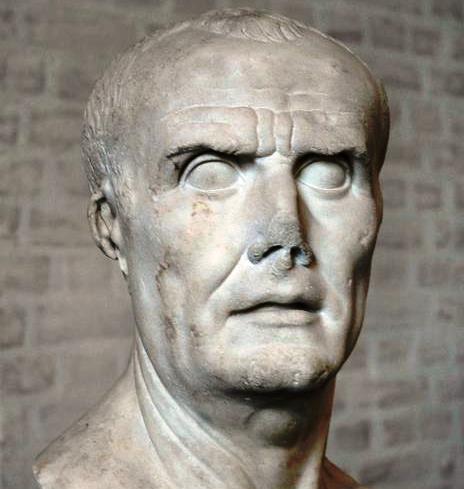 |
|
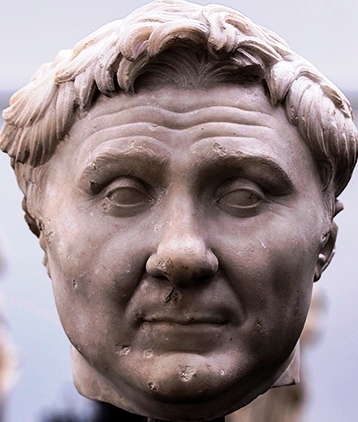 |
|
Marius |
|
Pompey |
| |
|
|
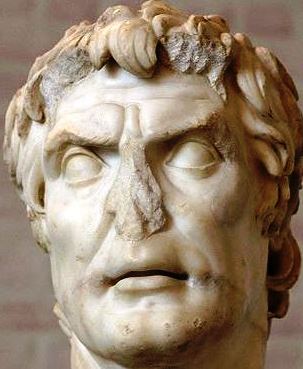 |
|
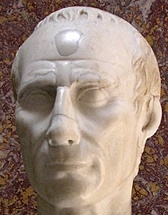 |
|
Sulla |
|
Caesar |
|
|
|
|
|
Marius: the Hero of the People
Was General Marius the
"ideal" type of Roman commander? He's looking straight ahead,
with intense, bulging eyes. He has a furrowed brow and bushy
eyebrows, a square jaw, somewhat sunken cheeks, and a large
forehead. Probably he had a strong nose. The sculptor has given
us a man of "virtus," the manly courage and
steadfastness that the Romans valued so highly in their military
leaders.
Marius showed his brilliance as a general three times: in
Spain, in North Africa, and in defense of the City of Rome.
He reformed Rome's political institutions and its Army, making both more favorable to ordinary Romans.
On the darker side, he plunged Rome into terrible Civil
Wars.
Marius started his military ascendancy in Spain. Spain had a
vital asset: silver. Marius fought brutal, guerrilla-style warfare
against native inhabitants of Spain. His reward: silver
mines.
Marius next took on the threat to Rome's grain supply by the
wily King of Numidia,
Jugurtha. Fighting in North Africa, Marius captured the
King and sent him to Rome, where Jugurtha was starved to
death.
Back to Rome: Tribes from northern Europe, the Cimbri and the Teutones, were migrating southward into southern France. When the tribes
unexpectedly decimated all three of the Roman Armies sent to
stop them, the road to Rome lay open. Marius was sent
after them.
He defeated the tribes decisively. Delirious with relief,
the Romans awarded Marius not one but two triumphal parades.
Marius and the common soldier: Rome's traditional,
summer-service Army had come from property-owning small
farmers. Marius turned it into a long-serving Army,
recruited from Rome's poorest citizens, those with little future.
They joined up for a regular
source of income, food, a chance for booty, and land upon
discharge. They became loyal to him rather than to the Roman Senate and People.
The new, much poorer "boots on the ground" recruit
couldn't afford equipment. Marius organized a central armory to issue each
soldier a pilum (javelin) and a pugio (dagger).
Marius asked Rome to give its veterans, upon discharge, a
plot from Rome's public domain lands to support themselves
and their families.
|
|
 Caius
Marius, 157-86 BC. Caius
Marius, 157-86 BC.
Marius started gloriously, a genuine war hero and consul an
unprecedented 7 times, but ended badly.
His plan to give land to the veterans lay the ground for the Civil
Wars. Others were already using the public land for private
profit. They deeply resented losing their privileges.
In his later consulships, he became increasingly
paranoid. Plutarch tells us Marius "thirsted for blood, and
kept on killing all whom he held in any suspicion."
Finally, out of sheer greed, he unseated the rightful
military commander in the East, Sulla. With this act, he took Rome
into the civil conflict that punched very deep holes into Rome's social
and political fabric.
Marius died seventeen days into his 7th consulship, at age
71.
|
|
|
|
|
|
|
|
|
Sulla:
The General Who
Killed the Republic
In Munich, you can
see an especially ferocious portrait bust. This is Sulla, the man who
spelled the end of the Republic. The eyebrows jut in an
upward slash, the piercing eyes bulge, the nose must have been
substantial. This was a person you would want to give a wide
berth to.
Sulla had first made his military reputation in North Africa
under Marius in defeating Jugurtha, the King of Numidia.
Jugurtha seemed
to excel in bribing Rome's highest officials. Sulla, under
Marius' leadership, captured Jugurtha through better
treachery--his father-in-law coughed him up.
In 101 BC Sulla joined Marius in the
campaigns against the Germanic tribes. He was key in
defeating the Cimbri. The Cimbri tribe, women and
children as well as the male warriors, was extinguished from
the face of the earth. Rome
breathed a sigh of relief.
In southern Italy, Rome's allies, who were not "citizens" of
Rome, revolted over unequal taxation. After all, they were
allies. The Romans thought otherwise--an ally to them was
someone they had conquered and then allowed to exist-- and
sent Sulla to defeat them.
Was Sulla becoming too successful? The Senate and Sulla
tangled, twice. The Senate, led by Marius, took away his
command over the Eastern army. Sulla, tossing aside
centuries of Roman tradition and law, led his soldiers in a
"March on Rome." The Roman government sent emissaries to
reason with him. His soldiers stoned them to death. Sulla
won. Marius fled.
The second time they tangled,
Sulla engaged in scorched earth policy from Athens to Rome,
sparing neither Roman citizen nor ally. Outside the Colline Gate in Rome, Sulla won
a final battle against the Roman Senate and their
supporters.
He became
"dictator," the first in 120 years. His victor's
speech to the cowering Senate was accompanied by the screams
of thousands of soldiers being executed a short
distance away in the Forum.
As dictator, Sulla "cleansed" the elite of Rome. The independence of the old Senate and of elected Roman
officials was broken, the economic underpinnings of rivals
wiped out. Sulla's bloodbaths and confiscations against fellow
Romans scarred Roman consciousness for the next 80 years.
|
|

Sulla
(Lucius Cornelius
Sulla, 140-78 BC).
Munich: Glypothek.
Sulla had exceptionally fair skin that showed
red marks later in life, blue or grey eyes, and a mane of reddish-blond
hair. He was fond of good food and dancers and
actresses, a dissolute life-style for Romans.
Sulla was the first Roman general to lead a Roman Army
against the city of Rome and its duly elected government.
The author Pausanias related several
centuries later, with a hint of relish, that Sulla died
"seething with maggots (possibly
lice).
His early apparent good luck came round to so
terrible an end."
|
|
|
|
|
| |
|
|
Pompey the Great
In this portrait bust, the
sculptor has given Pompey a self-satisfied look. As well he
might: Pompey was called "Pompey the Great" for
good reason. At a young age, he raised a private Army and refused
to disband it after it won again and again in the long Roman
Civil Wars.
The Senate, not knowing quite what to do with him and his
Army, decided to forgive all and make his acts legal. They
gave him plum military assignments and celebrated his victories with three "triumphs."
Pompey's last
triumph was given for his generalship against the most
resilient of foes, Mithridates.
Mithridates was the King of Pontus (in northern Turkey on
the south shore of the Black Sea). Mithridates had committed
an act of atrocity horrifying even by ancient standards.
After invading the Roman province of "Asia" (modern Turkey),
he had ordered the massacre of every Roman and Italian man,
woman, and child, perhaps 80,000 total.
Mithridates and Rome had been at war for 23 years when Pompey
arrived. Pompey swept through Asia , and gave Mithridates
his final defeat. Pompey claimed to
have killed, captured, or defeated over 12 million people in
his Eastern campaigns, and accepted the surrender of 1500
towns and fortified places.
Pompey returned from Asia as one of the wealthiest man in
Rome. His ostentatious third "triumph," for his Asia
victories, started on his 45th birthday and lasted two
days. He rode in the parade in a chariot studded
with pearls. A portrait of him, made of rare pearls and
gemstones was prominently displayed. The captured silver rolling past the
spectators was equal to the annual tax revenue of the entire
Roman world.
When the throne of Mithridates and a gold statue of the
defeated King appeared, no one could doubt that Pompey had made
Rome into a true world empire.
|
|
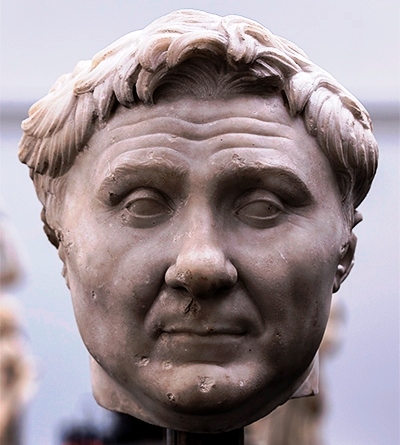
Pompey the Great,
(Gnaeus Pompeius
Magnus, 106 BC-48 BC). Ny Carlsburg Glyptothek, Copenhagen.
Photo: courtesy
Penelope@chicago.edu
Pompey, once a
great general, died a sad death.
Pompey married the only daughter of
Julius Caesar. They were very much in love. When she died
at a young age in childbirth, Pompey and Caesar's bond broke, and the
two led different sides in the subsequent civil war.
Pompey panicked against Caesar at the battle at Pharsalus, northwest of Athens, and lost.
Committing the worst of all acts for a Roman General, he
abandoned his army and fled to Eqypt. The
Egyptians
assassinated Pompey and presented his
head to Caesar. |
|
|
|
|
|
|
|
|
Julius Caesar
Americans know Julius Caesar for three things: "All Gaul is
divided into three parts," the opening words of his
Gallic Wars;
his affair with Cleopatra; and his murder on the Ides of
March, including Shakespeare's words "Et tu, Brute?"
As a military
commander,
Caesar owned the Roman trait of "virtus" --physical
courage, military skills, and moral leadership over his
troops. He could deploy his army with control, paying
attention to the smallest details of the units and the
combat at hand.
His ability to see options on the battlefield and make the
brilliant decision was uncanny, and Caesar celebrated four
military "triumphs" for his accomplishments. The first for
victories in Gaul against
many large tribes. The second for victories in Eqypt. The
third for his battles in Asia against the Asian ruler
Pontus. The fourth for victory in North Africa against the King of Numidia.
Some of his most important victories--those of the
Roman Civil Wars--could not be mentioned.
At 19, he
received the rarely-award
"corona civica" for personal bravery.
A simple oak wreath, the
corona civica
marked a
solider as a true hero, one who had saved the lives of other Roman soldiers
at considerable risk to himself. When the hero entered a Roman
event such as a festival, all attending, even Senators, rose to their feet
in gratitude and respect.
Caesar was just a fearless at 52, when he personally led his Army to defeat the great Pompey at the
battle of Pharsalus in the Civil Wars.
Charismatic and
empathetic, Caesar connected with his troops. He addressed
them as "comrades," and sometimes as "citizens," never as
"soldiers" or "men." Caesar
led his columns in the field, sometimes on
horseback, often on foot, showing his
officers and men that he expected of himself
exactly what he expected of them.
He
trained with his men, leading them on foot,
leading at night, leading in the rain, leading over
difficult terrain. He slept in the open air with his
soldiers and rode with his cavalry for hours on end, even
though he suffered bouts of epilepsy and other ill health.
Julius Caesar didn't think he would have any problem with
the gods: his father's family were descended, so
he said, from Venus herself.
|
|

Gaius
Julius Caesar, (100 BC-44 BC).
Caesar was not particularly wealthy before he became Consul
and Commander, but he was witty and charming to men and to
women.
Rome's most aristocratic women found him
irresistible. Women could not play an overt role in
politics, but their connections furthered Caesar's political and military careers.
He wrote and
spoke (orated) well. Even the great Cicero admired his
talents. His connections backed him. He backed himself by
taking on huge debt to win in politics.
Caesar was thought to be one of Rome's great
lovers. His affairs could be short or long. He
married three times: to Cornelia, to Pompeia, and to Calpurnia,
and had a long affair with Servilia, mother of his assassin
Brutus. And then there was Cleopatra...
|
|
|
|
|
|
NOTABLE LOSERS |
|
|
The Etruscans
The Etruscans were an older, more advanced society than the
early Romans. At one time, an Etruscan royal dynasty, the Tarquins,
may have ruled Rome, producing "Etruscan Rome". The
art and architecture of the early Roman city was certainly
Etruscan and Greek, produced by Etruscan craftsmen.
In time,
the balance swung. Rome conquered Etruria, and Etruria
became Roman, rather than Rome becoming Etruscan.
The city built by the Etruscans became their nemesis and
conqueror. Over a period of 300 years, all of the various
Etruscan city-states fell to Rome.
Enmity and jealousy
pulled them apart. Their own priests said their culture's
lifespan was at an end. By 90 BC Etruria had declined into
just another region of Italy, ruled by the Romans.
Etruscan
culture and language were erased from the face of the earth.
|
|

Roman Triumph over the Etruscans at Veii.
16th c fresco by Francesco Salviato. Florence, Palazzo Vecchio. |
|
|
|
|
|
|
|
|
Pyrrhus
The term "Pyrrhic Victory" comes from one of the
strongest opponents of the early Romans: Pyrrhus, King of
Epirus, in northwestern Greece.
The tribes, settlements, and
cities of the Italian Peninsula were being threatened by
the Romans. They hired Pyrrhus, a Greek King, to get rid of the
Romans since they could not do so themselves. He almost
succeeded. He twice defeated the well-organized and numerous
Romans, at the Heraclea in 280 BC and at Asculum in 279.
Pyrrhus put together a modern-looking army--
professional soldiers, who used pikes in a phalanx, with war
elephants to supply the fear-factor and cavalry for
mobility. As a general, he was a far cry from the
tribal chieftain or the faction-bound city-state that the
Romans easily toppled.
The cost to Pyrrhus from these victories was heavy.
After he Battle of Asculum,
Pyrrhus lost his headquarters camp. Personally, he suffered a life-threatening javelin wound.
Pyrrhus
allegedly said that one more such triumph against the
Romans would ruin him.
Worse, the Romans refused to give up and come to terms after
their two defeats. This behavior defied the ancient world's
military codes. Pyrrhus went home to Greece without a declared
victory. In the end, he was not considered a winner.
With Pyrrhus out of the picture, the Romans rapidly defeated
those who had hired or sided with him. Roman hegemony over
the Italian peninsula appeared unstoppable.
|
|

Pyrrhus, King
of Epirus, Greece.
( 319-272
BC)Bust, National Archeological Museum of Naples.
Courtesy:
Wikipedia.
After
'defeating' the Romans, King Pyrrhus returned to the Greek
world. While fighting in the city of Argos, a woman on top
of a house flung a tile down onto him. Down he went; an
enemy soldier ineptly severed his head from his body.
No one thought it disgraceful. |
|
|
|
|
|
|
|
|
|
|
|
|
Hannibal
: the Second Punic War
"The elephants go on and smash everything under
their feet: they (i.e., the Roman infantry) go like tomato
juice..."
On
Hannibal's wine-fed elephants, by S. Frankello, German
elephant trainer. His video:
https://www.youtube.com/watch?feature=player_detailpage&v=0gbPIyCuGTAHannibal of Carthage: to us,
the general with the most exotic, unbelievable, heroic
story-line: he leads a large army through the Alps, in
winter, with a corps of elephants. After descending to the
other side, in Rome’s home court, he smashes the waiting
Roman Army.
Hannibal: to the Romans, this
commander is nuts. Crossing a high mountain range in
winter? With a large army to supply and keep together?
Running a gauntlet of mountain tribes situated high above in
the narrow passes? With 37 elephants, not known to like snow
and cold? With no supply base or allies on the Italian side?
No
Roman general could have thought Hannibal was much of a
threat. Rome was the “new-style” power: super-offensive,
coming back again and again with endless supplies of
manpower, until complete victory. The quality of generalship
did not much matter. “Old-style” powers, like
Carthage, could afford to lose only around 5-10% of
their force, so they maneuvered, engaged in siege warfare,
and negotiated settlements.
The Roman Army trained their
soldiers in close, hand-to-hand field combat. Their
large-scale units could operate in controlled, disciplined
formations. How could an "Old-style" army survive even
a week in Italy?
Hannibal broke the mold. He
proved that brilliant generalship could win the day. In
three stunning victories in Italy within two years—at Trebia, Trasimene,
Cannae-- the Romans were decimated. Then sucked into an 18
year war that claimed as many as 1/3 of all Roman males.
Eventually, the Romans
wised up and attacked Carthage even though Hannibal was
still at large in Italy. Hannibal returned to Carthage to
defend his homeland but lost the battle of Zama. After
Carthage's surrender, he lived another 20 years. He entered
politics, became a reformer, then fell afoul of the Roman
authorities in Carthage. He fled to Asia (modern Turkey),
where he served various kings fighting the Romans. Soon he
was on Rome's Most Wanted list. About to be fingered, he
committed suicide around age 66.
Of the 37
original elephants, those who made it over the Alps died in their
first year in Italy from an unexpected prolonged freeze.
|
|
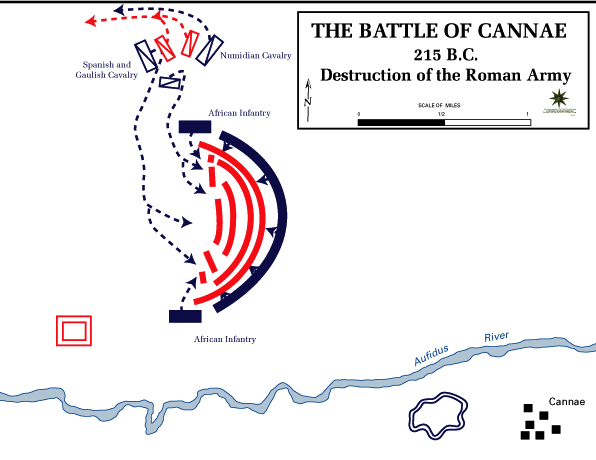
Hannibal defeats
the Romans at the battle of Cannae, 216 BC. The
Carthaginians are shown in blue; the Romans in red.
Detail of diagram courtesy
of US Military Academy.
I've always been
moved by how little evidence exists today for battles where
thousands lost their lives.Trebia,Trasimene, and Cannae are no different.
Little archeological evidence has been uncovered--few pieces of
armor, projectiles, or remains of the many soldiers who
perished.
For Cannae, no memoirs of those who fought survive. What we
know of the battle comes from two ancient Romans writing
much later: Polybius and Livy. Nothing from the Carthaginian
side survives.
Strength and
casualties (approximate)
Trebia: Hannibal 30,000 men; 4,000 lost
Rome: 42,000
men; 32,000 lost
Trasimene: Hannibal: 30-50,000 men; 1500 lost
Rome: 30-40,000 men; 15-30,000 lost
Cannae: Hannibal: 50,000; 5500 lost
Romans:
86,000 men; 67,000 lost
The casualty rate at Cannae--for a single day's
fighting, as a percent of the force-- was not
reached again in the West until World War I.
|
|
|
|
|
SOURCES
For the general reader:
The best single volume is
by Jonathan P.
Roth,
Roman Warfare: the Cambridge Introduction to Roman Warfare.
2009
Adrian Goldsworthy
has written a number of recent books on warfare and the army
in the early period that are both interesting to read and
rely on primary resources. On the Army, try his:
The Roman Army at War;
Roman Warfare; and
In the Name of
Rome.
Goldsworthy's biographies
include: Anthony
and Cleopatra; (Julius) Caesar, The Life of a Colossus;
and Augustus.
Battle-oriented ones are:
The Fall of Carthage
and the Punic Wars, and Cannae.
Scullard, H. H. , The Elephant in the Greek and Roman World.
1974.
For more advanced readers:
Cornell,T. J., The
Beginnings of Rome.
1975.
Galinksy, Karl,
Augustus.
2012.
Harris, William.V.,
Rome in
Etruria and Umbria.
(1971).
Osgood, Josiah,
Caesar's Legacy: Civil
War and the Emergence of the Roman Empire.
2006.
Rich, John and D. Graham Shipley,
War and Society in the
Roman World. 1993.
------------------------------------------------------------------------------
Updated 21-July-2016. You may contact me, Nancy Padgett,
at
NJPadgett@gmail.com. |
|
To read the primary sources:
Sage,
Michael, The
Republican Roman Army: a Sourcebook.
2008
Horace translation by A.S. Kline,
Horace: The
Epodes and Carmen Saeculare
from his web site
http://www.poetryintranslation.com
Internet
resources
Bryn Mawr Classical Review
http://bmcr.brynmawr.edu/
Lacus Curtius
http://penelope.uchicago.edu/Thayer/E/Roman/home.html
Livius.org
http://www.livius.org/
For casual readers and wargame buffs:
BBC History Magazine
http://www.historyextra.com/category/topics/era/romans
Ancient Warfare
http://www.karwansaraypublishers.com/pw/ancient-warfare/
UNRV
http://www.unrv.com/
|
|
|
|
|
|